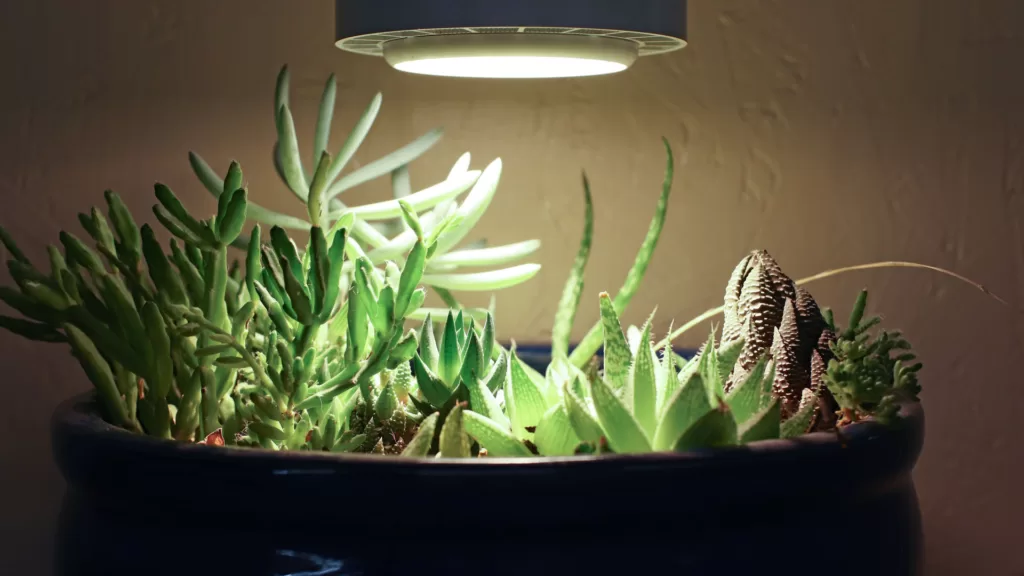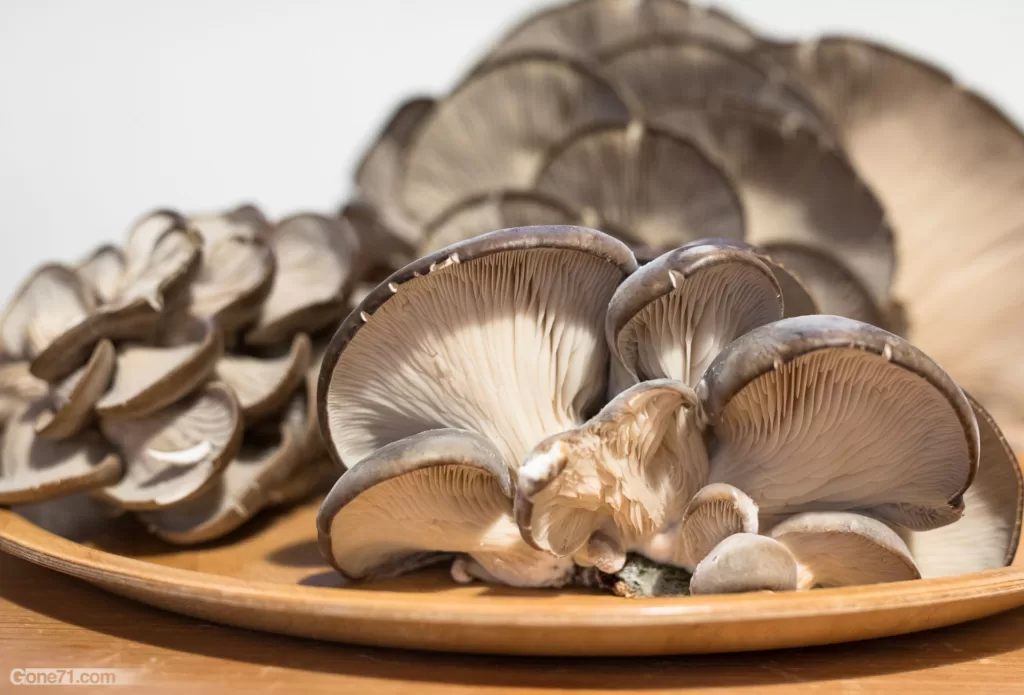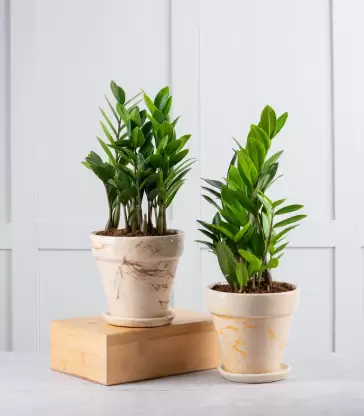Succulents prefer bright, indirect sunlight. Therefore, a grow light with a color temperature of around 6000K and a high PAR (Photosynthetically Active Radiation) rating would work well for succulents. The light should also be placed close to the plants, around 6-12 inches away, but not so close that it burns the leaves. LED grow lights are a popular choice for succulents as they tend to be energy efficient and emit little heat.
Table of Contents
How to choose grow light for succulents
When choosing a grow light for succulents, there are a few key factors to consider:
- Color Temperature: Succulents prefer bright, indirect sunlight, so a grow light with a color temperature of around 6000K is ideal. This will mimic the natural light that succulents would receive if they were growing outdoors.
- PAR (Photosynthetically Active Radiation) rating: A high PAR rating is important as it indicates the intensity of the light. Succulents need a lot of light to thrive, so a high PAR rating is necessary to ensure that they receive enough light.
- Wattage: The wattage of the grow light will determine how much energy it uses and how much heat it emits. Succulents do not tolerate high temperatures, so a grow light with a low wattage is ideal.
- Size of your grow space: The size of your grow space will determine how many grow lights you need. You’ll need more lights for a larger space and less for a smaller space.
- Type of light: LED grow lights are a popular choice for succulents as they tend to be energy efficient and emit little heat.
- Distance: The light should be placed close to the plants, around 6-12 inches away, but not so close that it burns the leaves.
It’s also recommended to check the Spectrum of light, UV and IR radiation, as succulents need a balanced spectrum of light to grow.
How to use led grow lights for succulents
When using LED grow lights for succulents, there are a few key steps to follow:
- Place the lights close to the plants: LED grow lights should be placed around 6-12 inches away from the succulents, but not so close that they burn the leaves. This will ensure that the plants receive enough light to thrive.
- Choose the right spectrum of light: Succulents need a balanced spectrum of light to grow, so it’s important to choose an LED grow light that provides a full spectrum of light.
- Gradually increase the light intensity: Start by exposing the succulents to low intensity light for a few hours a day, and gradually increase the intensity over time. This will help the plants to adjust to the new light conditions.
- Provide a consistent light schedule: Succulents need a consistent light schedule to thrive, so it’s important to provide them with the same amount of light each day.
- Monitor the temperature: LED grow lights emit little heat, but it’s still important to monitor the temperature to ensure that it doesn’t get too hot. Succulents do not tolerate high temperatures, so it’s important to keep the temperature cool.
- Keep the humidity level low: Succulents prefer low humidity, so make sure to keep the humidity level low in your grow space.
- Fertilize and Water: Don’t forget to fertilize and water your succulents as well. They can absorb the nutrients from the soil and water to grow.
It’s also recommended to check your succulents regularly for any signs of stress, such as yellowing leaves or stunted growth, and adjust your light schedule accordingly.

Should I use grow lights for succulents?
Grow lights can be a useful tool for growing succulents indoors, especially if you don’t have access to natural sunlight. They can provide the light that succulents need to thrive, and they can be used to extend the growing season or to grow succulents in a location that doesn’t receive enough natural light. However, it’s important to choose the right type of grow light and to use it correctly to ensure that the succulents receive the right amount of light.
It’s also worth noting that succulents can grow well with natural light, but it depends on the species of succulents you have and the location where you’re planning to put it. Some succulents can tolerate low light conditions, but others require brighter light. You should consider the amount of natural light that your plants will receive before deciding whether to use grow lights or not.
It’s also important to mention that succulents need a dormant period, this is a period of time where they don’t need as much light and water, during this period you should reduce the light and water, otherwise they may not survive.
In summary, while grow lights can be a useful tool for growing succulents indoors, it’s important to consider the amount of natural light that your plants will receive, the species of succulents you have and the dormant period of your succulents before deciding whether to use grow lights or not.
What LED lights are good for succulents?
When choosing LED lights for succulents, it’s important to look for lights with a high PAR (Photosynthetically Active Radiation) rating and a color temperature of around 6000K. This will mimic the natural light that succulents would receive if they were growing outdoors.
Some popular LED grow lights for succulents include:
- Phlizon LED Grow Light: This light has a high PAR rating and a color temperature of 6000K, making it ideal for succulents. It also has a low heat emission and energy efficient.
- Roleadro LED Grow Light: This light has a full spectrum of light that is suitable for all stages of plant growth, and a color temperature of 6000K. It also has a high PAR rating and low heat emission.
- Viparspectra LED Grow Light: This light has a high PAR rating and a color temperature of 6000K. It also has a full spectrum of light that is suitable for all stages of plant growth.
- Mars Hydro LED Grow Light: This light has a high PAR rating, a color temperature of 6000K, and a full spectrum of light that is suitable for all stages of plant growth.
- King Plus LED Grow Light: This light has a high PAR rating and a color temperature of 6000K. It also has a full spectrum of light that is suitable for all stages of plant growth.
These are just a few examples of LED grow lights that are well-suited for succulents. It’s important to check the light spectrum, UV and IR radiation, as succulents need a balanced spectrum of light to grow. Also, it’s recommended to check the distance that the lights need to be placed from the plants, the wattage and the size of your grow space, to ensure you have the right amount of light for your succulents.
Succulent grow light reddit
Many succulent growers on Reddit recommend using LED grow lights with a high PAR (Photosynthetically Active Radiation) rating and a color temperature of around 6000K. This is because succulents need bright, indirect sunlight to thrive and LED grow lights can provide this type of light without producing too much heat.
Also, succulent growers on Reddit recommend to use a full spectrum LED light that provides a balance of red, blue, white, IR and UV light. Many succulent growers also recommend using a timer to control the light schedule, usually 12-14 hours of light per day, to mimic the natural daylight cycle.
Additionally, it’s important to monitor the temperature and humidity level in the grow space and adjust the light schedule as needed. It’s also recommended to check succulent grow light communities, such as succulent forums, blogs, and social media groups, to get more information and advice on how to use grow lights for succulents.

Grow light bulb for succulents
When choosing a grow light bulb for succulents, there are a few key factors to consider:
- Color Temperature: Succulents prefer bright, indirect sunlight, so a grow light bulb with a color temperature of around 6000K is ideal. This will mimic the natural light that succulents would receive if they were growing outdoors.
- PAR (Photosynthetically Active Radiation) rating: A high PAR rating is important as it indicates the intensity of the light. Succulents need a lot of light to thrive, so a high PAR rating is necessary to ensure that they receive enough light.
- Wattage: The wattage of the grow light bulb will determine how much energy it uses and how much heat it emits. Succulents do not tolerate high temperatures, so a grow light bulb with a low wattage is ideal.
- Spectrum: The bulb should have a full spectrum of light, including red, blue, white, IR and UV, to provide the right balance of light for succulents.
- Distance: The light should be placed close to the plants, around 6-12 inches away, but not so far that it can’t reach the plants and not so close that it burns the leaves.
Some examples of LED grow light bulbs that are well-suited for succulents include:
- SunBlaster T5HO, this bulb has a color temperature of 6500K and a high PAR rating.
- Agrobrite T5, this bulb has a color temperature of 6500K and a high PAR rating.
- GE BR30 LED Grow, this bulb has a color temperature of 6500K and a high PAR rating.
It’s important to keep in mind that succulents need a consistent light schedule and a dormant period, so it’s recommended to use a timer to control the light schedule, usually 12-14 hours of light per day, to mimic the natural daylight cycle.
Best grow light for succulents reddit
Many succulent growers on Reddit recommend using LED grow lights with a high PAR (Photosynthetically Active Radiation) rating and a color temperature of around 6000K. This is because succulents need bright, indirect sunlight to thrive and LED grow lights can provide this type of light without producing too much heat.
Also, succulent growers on Reddit recommend to use a full spectrum LED light that provides a balance of red, blue, white, IR and UV light. Many succulent growers also recommend using a timer to control the light schedule, usually 12-14 hours of light per day, to mimic the natural daylight cycle.
Additionally, it’s important to monitor the temperature and humidity level in the grow space and adjust the light schedule as needed. It’s also recommended to check succulent grow light communities, such as succulent forums, blogs, and social media groups, to get more information and advice on how to use grow lights for succulents, where you can find more specific information from people who have experience with succulent grow lights.







